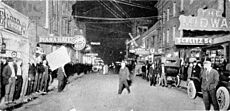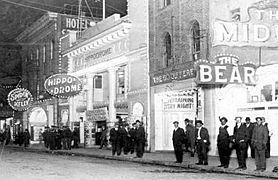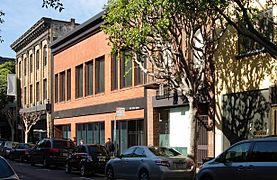Terrific Street facts for kids
Terrific Street was a lively entertainment area in San Francisco during the early 1900s. It was part of the city's famous Barbary Coast neighborhood. This street was full of dance halls, jazz clubs, and places to get drinks. Terrific Street was mainly on one block of Pacific Street. This street was one of the first to be built through San Francisco's hills. It started near Portsmouth Square and went east towards the shipping docks. The main part of Terrific Street was between Kearny and Montgomery streets.
Musicians first used the name 'Terrific Street' in the mid-1890s. They used it to describe the great music played in the clubs there. San Francisco's first jazz clubs were found on this street. At first, the music was mostly ragtime and slow blues. But by the early 1900s, the clubs started playing early forms of jazz. Many famous performers visited Terrific Street. These included actress Sarah Bernhardt and ballet dancer Anna Pavlova. Musicians like Sophie Tucker, Al Jolson, and Jelly Roll Morton also came.
Dancing was a big part of Terrific Street's appeal. Many popular dance steps were created there. These included the Texas Tommy and the Turkey Trot. However, Terrific Street did not last long. Its popularity began to fade by 1921. This happened after a newspaper tried to shut it down. Also, the Police Commission placed strict rules on its dance halls.
Contents
Why Terrific Street Ended
One popular dance, the Texas Tommy, surprisingly helped lead to the end of Terrific Street. When this dance was announced at a local theater, many worried citizens and police went to see it. They were surprised to find nothing wrong with the energetic dance.
The Texas Tommy then became very popular with young people. But older generations, who had not even seen the dance, started to criticize it. Parents worried the dance would harm their children's behavior. At the same time, businesses near Terrific Street added to the problem. They wanted to get rid of the dance halls that were competing with them. By 1912, the public began to fear and oppose all ragtime dances. This was due to a growing newspaper campaign against the Texas Tommy.
The Newspaper's Role
William Randolph Hearst owned the Examiner newspaper. He was known for a style of reporting called 'yellow journalism'. Hearst played a big part in the closing of Terrific Street. In September 1913, just before an election, Hearst's Examiner started a major campaign against the area. The newspaper published a full-page article criticizing the district.
Just ten days after this article, the police commission made new rules. They said no dancing was allowed in any place that served alcohol in the district. Also, no women, whether employees or customers, were allowed in any saloon there. Even electric signs were forbidden. The police department had a lot of power over Pacific Street because San Francisco's city government was small.
Changes and Closures
Because of these new rules, some places that served drinks fired their female employees. They became regular saloons. Other businesses simply closed down. Some musicians moved to Los Angeles. Others went to Oakland's Seventh Street jazz scene. Some of the larger dance halls moved to other areas. They tried to stay open for a few more years by pretending to be dance schools. But they never became as popular as before.
After the 1913 alcohol ban, a place called the Thalia stopped serving drinks. It called itself a dance academy. It hired almost 100 women to dance with customers for a fee per dance. 'Dance academy' was a secret term for a taxi dance hall. This term was used for another twenty years as taxi dancing spread to other big cities. A report from 1913 said:
- In September 1913, the Police Commissioner stopped dancing in any place that sold alcohol.
- This rule ended dancing on the Barbary Coast.
- It led to the start of "closed" dance halls nearby.
- In these halls, girls were paid to dance with men.
- Customers paid ten cents for each dance, which lasted less than two minutes.
- About 600 girls worked in these "closed" dance halls.
These "closed" dance halls were the first type of modern taxi dance halls. They were called "closed" because usually only the taxi dancers were allowed inside. The final blow to the entertainment scene came in 1921. At that time, taxi dancing and its closed dance halls were made illegal. Also, Prohibition in 1920 meant no alcohol was allowed. By 1917, all the excitement of Terrific Street had disappeared.
Pacific Street Today
Pacific Street, now called Pacific Avenue, no longer has bars, dance halls, or entertainment clubs. Today, its narrow path is filled with offices, design companies, and law firms. Many of the original buildings from the Terrific Street era are still standing. The old Hippodrome dance hall, once known as the Moulin Rouge, is now an art supply store. You can even see one of the old secret tunnels from the Barbary Coast days in the basement of that art store.
The two pictures below show the same three buildings at different times. From left to right, they are Spider Kelly's dance hall, the Hippodrome, and Purcell's So Different Café. In the 2014 picture, Spider Kelly's old dance hall has brown bricks. The Hippodrome building has orange bricks. Purcell's So Different Café building has brown bricks and is behind a tree.
- Pacific Street – Then and Now
See also
- Barbary Coast
- 1906 San Francisco earthquake
- Gold Rush of 1849
- Jackson Square
- North Beach
- Jazz
- Blues
- Ragtime
- Taxi dance hall




